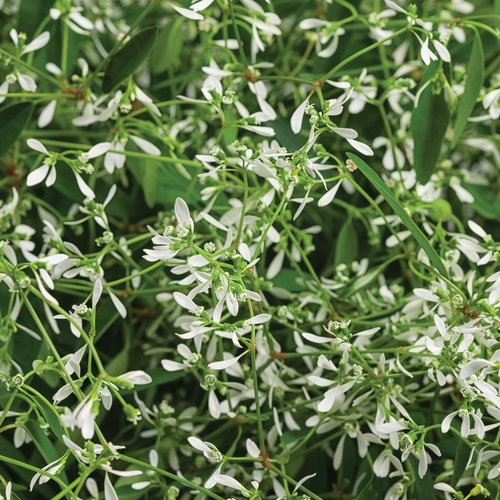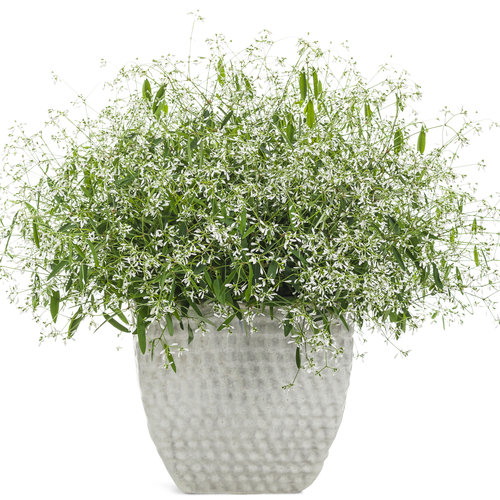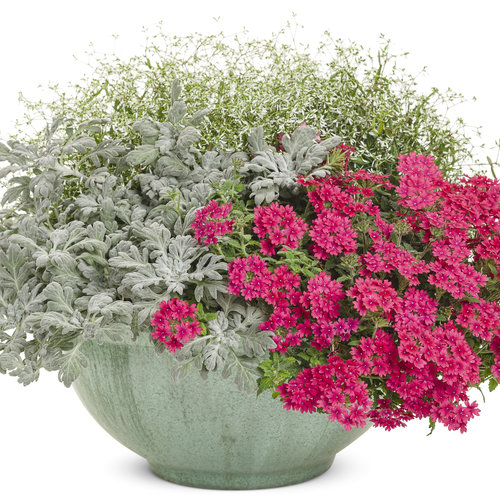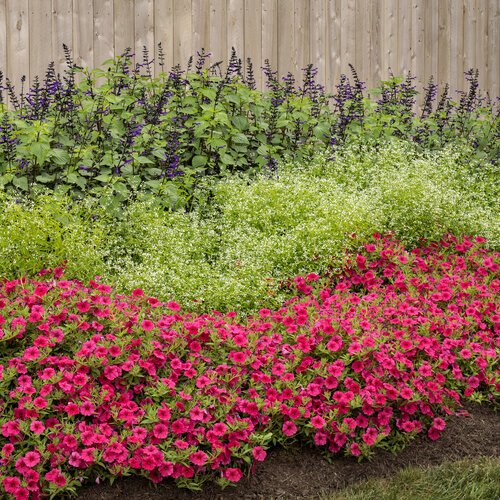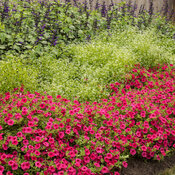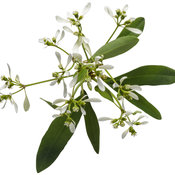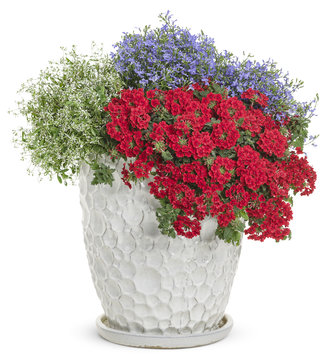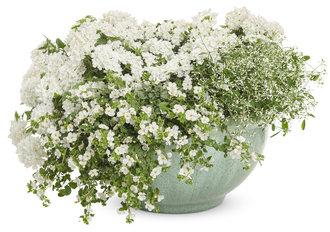The Diamond Euphorbia's are one of the most underrated summer annuals. These plants fly under the radar and at first sight might be overlooked but once you try it it will be a staple in your summer garden. This plant looks delicate but is tough and very easy to care for. If growing in a pot/container get a soil that is well draining of excess water but also holds on to some moisture and keep the soil evenly moist but not soggy. Let the soil dry out a bit and then give it a good soak... dry out, deep drink, dry out, deep drink, etc. Conditions (ex. sunlight, temperature, wind, humidity, soil makeup, etc.) dictate how long it will take for the soil to dry so keep on eye on it and you'll get the hang of it. Remember, it is much tougher than it looks so don't over water it by watering too frequently. This plant does best in morning and early afternoon sun, and although it can tolerate the intense late afternoon sun, I find it does better when it goes in the shade around 2:00 PM. For me that means this plant gets 6 hours of morning and early afternoon sun. Since I grow this in a container I give it a very, very diluted amount of water soluble fertilizer about once a month. This plant does not need a lot of fertilizer and giving it too much will actually do more harm than good. Get the sunlight and watering right and this plant will be sure to be a conversation starter with family, friends and neighbors!
Diamond Mountain® Euphorbia hybrid
- Part Sun to Sun
- Spring
- Summer
- Fall
-
24 - 36 Inches12 - 18 Inches24 - 36 Inches61cm - 91cm30cm - 46cm61cm - 91cm
Features
Heat- and drought-tolerant plants; clouds of airy white flowers all season; low maintenance. Much larger plants than Diamond Frost® with a great landscape presence and perfect for mixing with other vigorous plants.
Award WinnerContinuous Bloom or RebloomerLong BloomingHeat TolerantDeadheading Not NecessaryDrought TolerantResists:DeerCharacteristics
Plant Type:AnnualHeight Category:MediumGarden Height:24 - 36 Inches 61cm - 91cmSpacing:12 - 18 Inches 30cm - 46cmSpread:24 - 36 Inches 61cm - 91cmFlower Colors:WhiteFlower Shade:WhiteFoliage Colors:GreenFoliage Shade:GreenHabit:MoundedContainer Role:FillerPlant Needs
Light Requirement:Part Sun to SunThe optimum amount of sun or shade each plant needs to thrive: Full Sun (6+ hours), Part Sun (4-6 hours), Full Shade (up to 4 hours).
Maintenance Category:EasyBloom Time:Planting To FrostHardiness Zones:10a, 10b, 11a, 11bWater Category:AverageUses:Border PlantUses:ContainerUses:LandscapeUses:Mass PlantingUses Notes:Plant in landscapes, containers or large combinations that include other very vigorous plants.
Maintenance Notes:Diamond Mountain might look delicate and frilly, but nothing could be further from the truth. Diamond Mountain is actually pretty much tough as nails. She has performed well from North to South and coast to coast. While she does best in sun or part sun conditions, she does surprisingly well in shady conditions also. As you might suspect she is great in mixed containers and containers by herself, but don't discount her excellent performance when planted in the landscape. She needs little to no supplemental water and is extremely heat tolerant. She doesn't need to be deadheaded and shouldn't need much in the way of fertilizer either - she's a very self-sufficient gal. While you shouldn't need to trim her back, you can trim her back at anytime and she will just keep doing her thing.
Self-cleaning, no deadheading necessary.
Some shedding of flowers and leaves may occur indoors depending on light levels and watering.
Plants in the spurge family often will bleed a milky, white sap if cut or wounded. This sap is a form of latex. Most people will have little or no reaction due to sap exposure from the euphorbia that Proven Winners sells. However, people with sensitive skin or latex allergies should be cautious when handling euphorbia. Poinsettias are in this same family. If you have ever experienced a skin irritation due to contact with poinsettias you should be cautious with all euphorbia.
An application of fertilizer or compost on garden beds and regular fertilization of plants in pots will help ensure the best possible performance.
Fun Facts:2020 Annual of the Year.
-
5341321Browse reviews from people who have grown this plant.
-
Jordan, Nebraska, United States, 1 year ago
-
Very beautiful plant. Planted 6 under maple in shade along with other shade loving plants. Theme is white, pink, purple and their shades. People stop by to admire that patch. DM just make it more dreamy. I'm going to buy DM forever
Joshi, 4 years ago -
Diamond Mountain Euphorbia has been nothing short of spectacular this year in two of my large containers. I expected a lot from them and they did not disappoint! It is October 4th in NJ and they are still going strong. Visitors to my home stop in their tracks when they see this plant!
Kathleen Towle, New Jersey, United States, 6 years ago -
Such a nice filler in my hanging baskets! The honeybees love it too
Jennifer Winship, British Columbia, Canada, 6 years ago
Award Year Award Plant Trial 2018 Leader of the Pack - Late Season North Carolina State, JC Raulston Arboretum 2018 Top Performer University of Guelph 2018 Top Performer Ohio State University Chadwick Arboretum - Springfield 2018 Top Performer Penn State University 2018 Top Performer University of Georgia 2018 Top Performer Colorado State University 2018 Zoo's Best Cincinnati Zoo and Botanical Garden 2018 Top Performer South Dakota State - McCrory Gardens 2018 Perfect Score All Season University of Minnesota - Morris 2018 Leader of the Pack - Early Season North Carolina State, JC Raulston Arboretum - Born in the USARecipe
What you'll need:
-
1
-
1
-
1
-
- Antique WhiteRecipe
What you'll need:
-
1
-
1
-
1
-
- Venice LaceRecipe
What you'll need:
-
1
-
1
-
1
-
-



